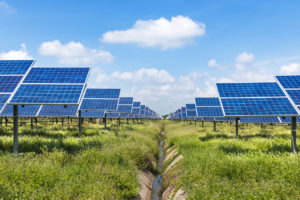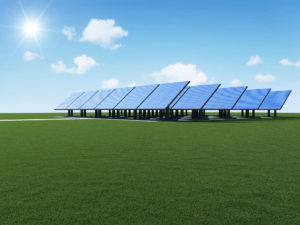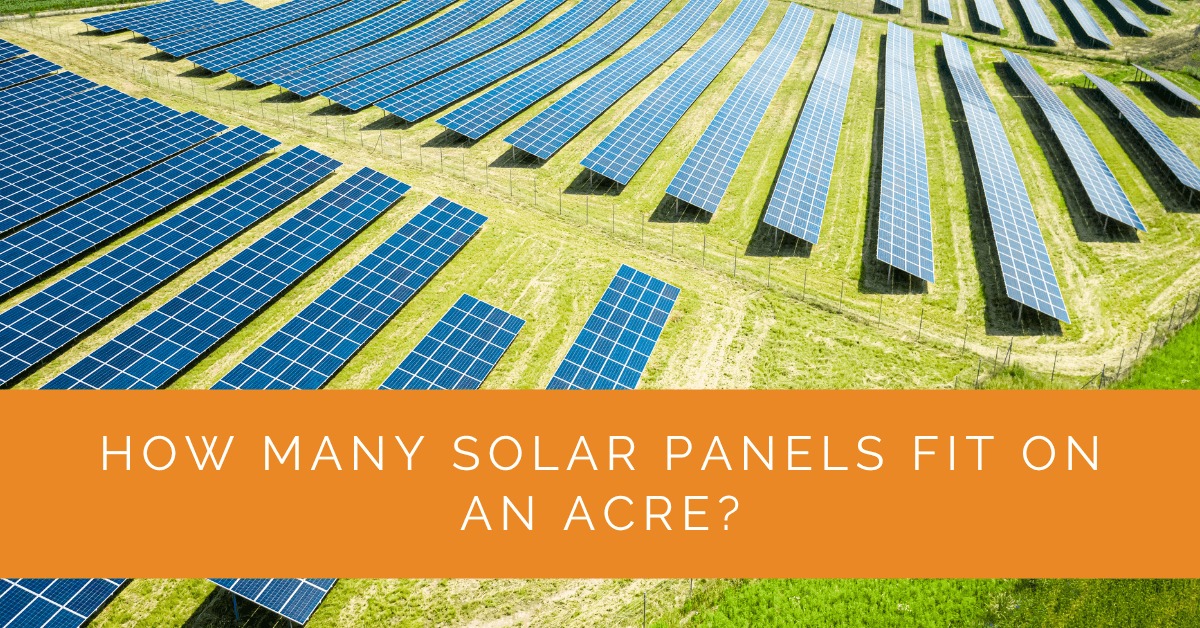The development of solar farms and utilizing solar energy have gained immense popularity in recent years. One key question in the planning stage of a solar project is: How many solar panels can be installed on an acre of land? In this article, we will delve into the factors that affect solar panel density, calculations to estimate the number of panels, strategies to maximize energy production, and considerations for solar farm profitability. Whether you are a landowner exploring solar farm options or a solar company planning a commercial solar project, understanding the potential of an acre of land in solar panel installation is crucial for optimal energy generation.
Contents
- 1 Key Takeaways
- 2 Factors Affecting Solar Panel Density
- 3 Calculating Solar Panel Density
- 4 Maximizing Solar Panel Density
- 5 Case Study: Maximizing Solar Panel Density on an Acre of Land
- 6 Expert Insights From Our Solar Panel Installers About How Many Solar Panels Fit on an Acre
- 7 Experience Solar Excellence with Us!
- 8 Conclusion
Key Takeaways
- Factors such as panel size, efficiency, mounting systems, setbacks, and spacing requirements significantly impact solar panel density and energy production in a given area.
- Accurate calculations, modeling tools, and innovative design strategies help optimize solar panel density while considering practical constraints and regulatory compliance.
- Advanced technologies, such as higher efficiency panels and tracking systems, can maximize energy capture and increase panel density while integrating solar with other technologies enhances system performance.
- For example, considering a solar panel size of 18 square feet (1.67 square meters) and an acre of land (43,560 square feet or 4,047 square meters), an estimated 2,420 solar panels could fit in that area. However, the density may vary based on site-specific conditions and project requirements.
- Collaborating with solar professionals and leveraging expertise ensures the most efficient use of available space, leading to higher energy generation and a more sustainable future.
Factors Affecting Solar Panel Density
When determining the density of solar panels, several factors come into play. Understanding these factors is essential for optimizing the efficiency and output of your solar panel system.
Panel Size and Efficiency
The size and efficiency of solar panels directly impact the density that can be achieved on a given area of land. Larger panels generally have a higher power output but occupy more space. Conversely, smaller panels may allow for higher density, but their power output may be lower. Striking the right balance between panel size and efficiency is crucial for maximizing the utilization of available space.
Additionally, advancements in panel technology, such as higher conversion efficiencies and improved power output, can contribute to higher panel density. When considering panel options, assessing the trade-off between size, efficiency, and power output is important to determine the most suitable panels for your specific needs.
Mounting and Racking Systems
The choice of mounting and racking systems plays a significant role in determining solar panels’ density. Ground-mounted systems are commonly used in solar farms and offer flexibility in panel arrangement. They allow optimal panel positioning and tracking of the sun’s movement throughout the day, maximizing energy production.
On the other hand, roof-mounted systems are popular for residential and commercial installations, where space is often limited. In these cases, the design and layout of the mounting system become critical in achieving the highest possible density while ensuring structural integrity and compliance with building codes.
Setbacks and Spacing Requirements
Regulatory setbacks and spacing requirements are essential considerations when determining solar panel density. Setbacks are defined distances that must be maintained between the solar panels and property boundaries, existing structures, or public roads. These setbacks ensure compliance with local regulations, promote safety and allow for proper maintenance and accessibility of the solar panel system.
Adhering to spacing requirements is also crucial for optimizing panel density. Adequate spacing between panels allows for efficient airflow and helps prevent shading, which can negatively impact energy production. Balancing the spacing requirements to maximize panel density is a key aspect of the design and layout process.

Calculating Solar Panel Density
To determine the density of solar panels in a given area, it is necessary to consider various factors and perform accurate calculations. By following these steps, you can estimate the number of panels that can be installed and optimize the use of available space.
Panel Spacing and Layout Design
Determining the optimal spacing between panels and designing their layout is essential for achieving the desired panel density. The spacing should allow for efficient energy production while considering maintenance access, safety requirements, and shading avoidance.
You can maximize the number of panels installed within a given area through careful design and layout planning without compromising their overall performance. This may involve variations in panel orientation, tilting angles, and row configurations to optimize energy capture and minimize shading effects.
Site Assessment and Terrain Analysis
Assessing the site and analyzing the terrain are crucial to calculating solar panel density. Understanding the topography, including slopes, elevation changes, and any obstacles, helps determine the practical, usable area for panel installation. Flat land is generally more conducive to achieving higher panel density, while hilly or uneven terrain may require additional considerations and adjustments in the layout.
By considering the available space and analyzing the site’s characteristics, you can determine the maximum number of panels that can fit within the designated area. This assessment involves precise measurements and considerations for setbacks, access roads, and other site-specific constraints.
Modeling and Simulation Tools
Modeling and simulation tools can be employed to calculate solar panel density accurately. These tools utilize advanced algorithms and data inputs to simulate the solar panel system’s performance under various conditions. They consider factors such as solar irradiation, shading analysis, and panel characteristics to provide accurate estimations of energy generation and panel density.
Through modeling and simulation, you can optimize the placement and orientation of panels, test different design scenarios, and assess the potential impact of shading or other external factors. These tools enable you to make informed decisions regarding panel density, ensuring the system operates at its maximum capacity while considering efficiency, accessibility, and other practical constraints.
Additionally, technological advancements have led to the development of software platforms specifically designed for solar system design and optimization. These platforms offer intuitive interfaces, comprehensive data libraries, and sophisticated algorithms that simplify calculating panel density. They provide detailed insights into energy production, shading analysis, and performance metrics, enabling you to fine-tune your solar panel system and achieve optimal density.
By utilizing modeling and simulation tools, you can enhance the accuracy and efficiency of your calculations, make informed decisions about panel density, and ultimately maximize the energy production of your solar system.

Maximizing Solar Panel Density
Many solar projects aim to achieve the highest possible panel density on a given land area. By implementing strategies to maximize density, you can optimize energy production and make the most efficient use of available space.
Advanced Panel Technologies
Advancements in solar panel technology have resulted in higher efficiency and power output, enabling you to generate more electricity within a limited space. Consider utilizing panels with advanced features such as higher conversion efficiencies, bifacial capabilities, or improved temperature coefficients. These technologies can significantly enhance energy generation and allow for higher panel density.
Tracking Systems
Solar tracking systems dynamically adjust the position of solar panels to track the sun’s movement throughout the day. By optimizing panel orientation and tilt angle, tracking systems can maximize energy capture and increase the overall density of your solar panel system. While the cost and complexity of tracking systems should be considered, they can be particularly beneficial in areas with significant variations in solar irradiation throughout the day.
Innovative Layout Designs
Exploring innovative layout designs can help maximize solar panel density. Consider unconventional panel arrangements, such as overlapping or staggered configurations, to fit more panels within a given area. However, balancing density with practical considerations such as access for maintenance, wiring, and airflow is important. Collaborating with experienced solar professionals can provide valuable insights into creative design strategies that optimize both density and practicality.
System Integration
Integrating solar panel systems with other technologies can enhance energy production and overall density. For example, combining solar panels with energy storage solutions, such as batteries, allows for better utilization of generated energy and reduces reliance on the grid. Additionally, integrating solar panels with complementary technologies like wind turbines or micro-hydro systems can create a hybrid renewable energy system that maximizes energy production within a limited space.
By adopting these strategies and leveraging technological advancements, you can achieve higher solar panel density, increase energy generation, and maximize the return on investment for your solar project. Remember that every solar project is unique, and finding the optimal balance between density, efficiency, and practicality requires careful planning, professional expertise, and thorough analysis of site-specific factors.
In conclusion, panel size, efficiency, mounting systems, setbacks, and spacing requirements significantly affect solar panel density. Accurate calculations, utilization of modeling tools, and implementation of strategies for maximizing density enable efficient utilization of available space. By incorporating advanced technologies, exploring innovative layout designs, and integrating solar with other technologies, you can further enhance solar panel density and optimize energy production. These approaches increase the overall capacity of your solar system and contribute to a more sustainable and efficient use of land resources.
Moreover, maximizing solar panel density becomes increasingly important as the demand for renewable energy grows. By utilizing available space more efficiently, we can generate larger amounts of clean, green energy and reduce our dependence on fossil fuels. Solar farms and community solar projects, in particular, can benefit from higher panel density as they aim to generate significant amounts of renewable energy on a larger scale.
It is worth noting that while maximizing solar panel density is desirable, it should not compromise other practical considerations. Access for maintenance, adequate spacing for ventilation, and compliance with regulatory requirements are crucial factors to ensure the long-term reliability and performance of the solar panel system.
Pursuing higher solar panel density requires a balance between technological advancements, efficient system design, and practical considerations. Collaborating with experienced solar professionals and utilizing state-of-the-art tools and techniques can help you achieve optimal results for your specific project.
By striving to maximize solar panel density, we can unlock the full potential of solar energy and make significant strides toward a more sustainable future. With careful planning, innovative approaches, and a commitment to renewable energy, we can harness the sun’s power to its fullest extent, driving the transition to a greener and more sustainable energy landscape.
Case Study: Maximizing Solar Panel Density on an Acre of Land
Background
At Solar Panels Network USA, we are dedicated to providing optimized solar solutions that maximize energy production. One of our recent projects involved designing a solar farm on a one-acre plot of land. The goal was to determine the optimal number of solar panels that could be installed while ensuring maximum efficiency and energy output.
Project Overview
A landowner in a rural area approached us with a one-acre plot designated for a solar farm. They aimed to maximize the number of solar panels on this land to generate as much renewable energy as possible. Our task was to conduct a detailed assessment and provide a layout that balanced density and performance.
Implementation
Panel Size and Efficiency:
We began by selecting high-efficiency solar panels with a power output of 300 watts each. These panels were chosen for their ability to generate more power per square foot, allowing for higher density within the available space. The size of each panel was approximately 18 square feet.
Mounting and Racking Systems:
To optimize the panel layout, we utilized ground-mounted racking systems. These systems provided the flexibility to adjust the tilt angle and orientation of the panels, ensuring maximum sunlight exposure throughout the day. The racking systems also allowed for easy maintenance access and compliance with local regulations.
Spacing Requirements and Layout Design:
We carefully calculated the spacing between panels to prevent shading and ensure efficient airflow. The layout included a 2-foot gap between rows and a 3-foot gap between columns, which balanced density with performance. This arrangement allowed us to fit approximately 2,420 panels on the one-acre plot, maximizing the use of available space.
Site Assessment and Terrain Analysis:
A thorough site assessment was conducted to analyze the terrain and identify any potential obstacles. The land was relatively flat, which facilitated a straightforward installation process. We also ensured that the layout complied with local setback requirements and provided adequate space for maintenance and access roads.
Modeling and Simulation Tools:
We used advanced modeling and simulation tools to optimize the panel layout further. These tools allowed us to simulate different design scenarios and assess the impact of shading, solar irradiance, and other factors on energy production. The simulations confirmed that our layout would maximize energy generation and efficiency.
Results
The optimized layout resulted in the installation of 2,420 solar panels on the one-acre plot. The high-efficiency panels and strategic layout design led to significant energy production, exceeding the landowner’s expectations. The solar farm generated enough electricity to power approximately 300 homes, showcasing the potential of maximizing panel density on limited land.
Summary
Maximizing solar panel density on an acre of land involves careful consideration of panel size, efficiency, spacing, and mounting systems. At Solar Panels Network USA, we leverage advanced technologies and detailed site assessments to optimize solar farm designs. This case study highlights the importance of strategic planning and professional expertise in achieving high energy output and efficiency.
By utilizing high-efficiency panels, optimal layout designs, and advanced modeling tools, we ensure that our solar installations make the most efficient use of available space. This approach not only maximizes energy production but also contributes to a more sustainable future by harnessing the power of the sun effectively.
Expert Insights From Our Solar Panel Installers About How Many Solar Panels Fit on an Acre
Panel efficiency plays a significant role in determining how many panels can fit on an acre. Higher efficiency panels produce more power per square foot, optimizing the use of available space.
Senior Solar Technician
Proper spacing between panels is essential to prevent shading and ensure optimal performance. Careful layout design can significantly enhance energy production even within limited space.
Lead Solar Installer
Utilizing advanced technologies like solar tracking systems can increase the number of panels per acre by maximizing sunlight exposure throughout the day.
Certified Solar Engineer
Experience Solar Excellence with Us!
Trust in Solar Panels Network USA, where our seasoned experts deliver top-quality solar solutions for homes and businesses nationwide. With a legacy of countless successful installations and a commitment to sustainable energy, we’re your reliable partner in the solar journey. Ready for a brighter, eco-friendly future? Call us now at (855) 427-0058 and harness the power of the sun!
Conclusion
Determining the number of solar panels that can fit on an acre of land is a complex process that requires careful consideration of various factors. Panel size, efficiency, mounting systems, setbacks, and spacing requirements all play a crucial role in maximizing solar panels’ density and optimizing energy production. While general guidelines and sample calculations are available, it is important to note that the specific number of panels will vary based on site-specific conditions and project goals. Seeking professional advice from solar experts and consultants is highly recommended to ensure accurate calculations and customized solutions for your solar project.
By making the most efficient use of available land and employing advanced technologies and design strategies, solar panel density can be maximized, leading to higher energy generation and improved return on investment. However, it is equally important to consider the financial aspects and profitability of the solar farm. Assessing the initial costs, maintenance expenses, power output, and potential ROI are crucial steps in determining the project’s economic viability. Additionally, exploring options for government incentives and long-term energy purchase agreements can further enhance the financial prospects of the solar farm.
Embracing renewable energy sources like solar power on even a single acre of land can significantly reduce carbon emissions, foster sustainability, and pave the way for a cleaner and greener future. With careful planning, precise calculations, and the expertise of professionals, solar panel installations can harness the power of the sun to generate clean, renewable energy and create a positive impact on the environment and the bottom line.
About the Author
Solar Panels Network USA stands at the forefront of solar energy solutions, driven by a team of seasoned solar engineers and energy consultants. With over decades of experience in delivering high-quality solar installations and maintenance, we are committed to promoting sustainable energy through customer-centric, tailored solutions. Our articles reflect this commitment, crafted collaboratively by experts to provide accurate, up-to-date insights into solar technology, ensuring our readers are well-informed and empowered in their solar energy decisions.

